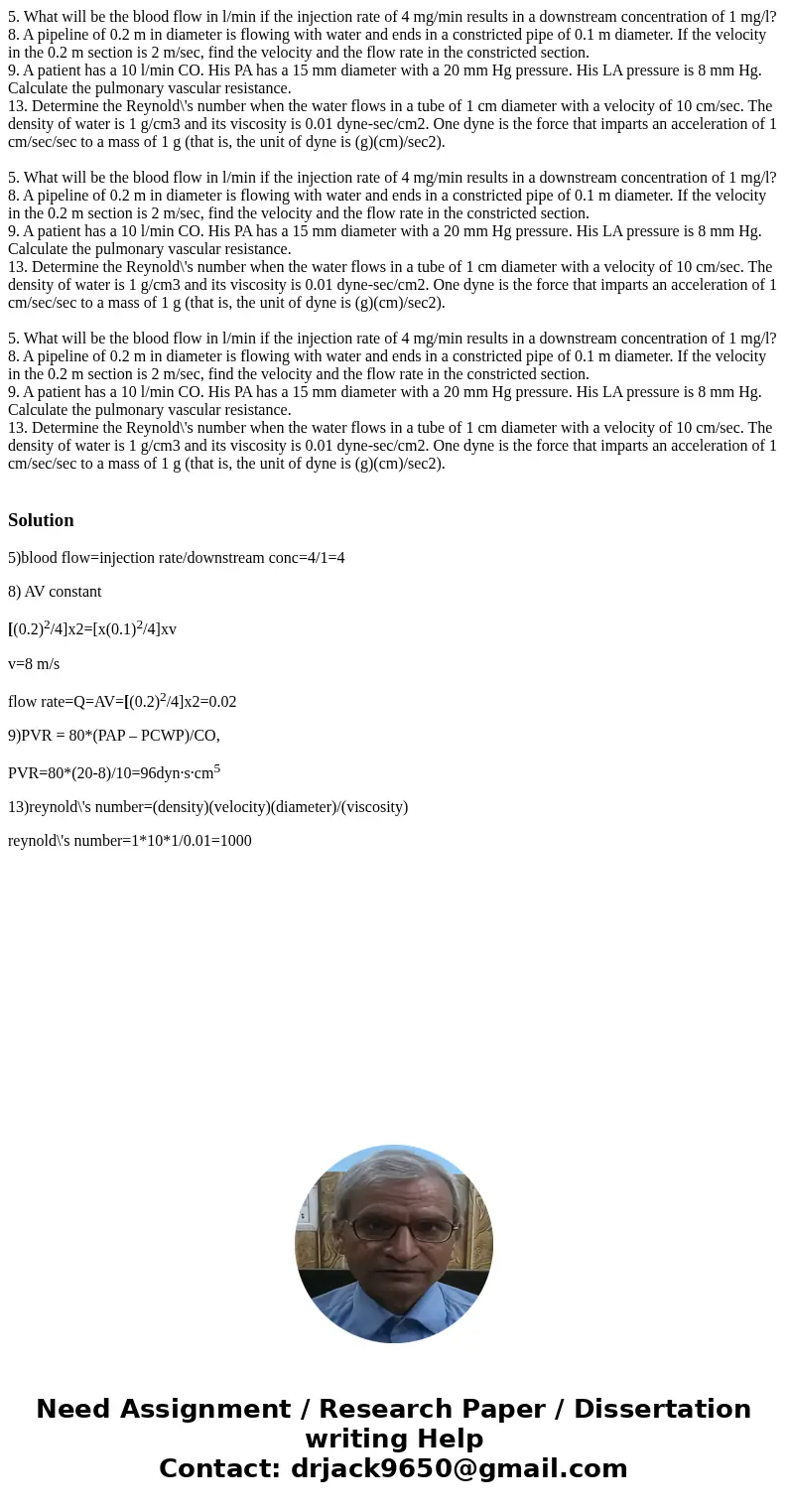5 What will be the blood flow in lmin if the injection rate
5. What will be the blood flow in l/min if the injection rate of 4 mg/min results in a downstream concentration of 1 mg/l?
8. A pipeline of 0.2 m in diameter is flowing with water and ends in a constricted pipe of 0.1 m diameter. If the velocity in the 0.2 m section is 2 m/sec, find the velocity and the flow rate in the constricted section.
9. A patient has a 10 l/min CO. His PA has a 15 mm diameter with a 20 mm Hg pressure. His LA pressure is 8 mm Hg. Calculate the pulmonary vascular resistance.
13. Determine the Reynold\'s number when the water flows in a tube of 1 cm diameter with a velocity of 10 cm/sec. The density of water is 1 g/cm3 and its viscosity is 0.01 dyne-sec/cm2. One dyne is the force that imparts an acceleration of 1 cm/sec/sec to a mass of 1 g (that is, the unit of dyne is (g)(cm)/sec2).
5. What will be the blood flow in l/min if the injection rate of 4 mg/min results in a downstream concentration of 1 mg/l?
8. A pipeline of 0.2 m in diameter is flowing with water and ends in a constricted pipe of 0.1 m diameter. If the velocity in the 0.2 m section is 2 m/sec, find the velocity and the flow rate in the constricted section.
9. A patient has a 10 l/min CO. His PA has a 15 mm diameter with a 20 mm Hg pressure. His LA pressure is 8 mm Hg. Calculate the pulmonary vascular resistance.
13. Determine the Reynold\'s number when the water flows in a tube of 1 cm diameter with a velocity of 10 cm/sec. The density of water is 1 g/cm3 and its viscosity is 0.01 dyne-sec/cm2. One dyne is the force that imparts an acceleration of 1 cm/sec/sec to a mass of 1 g (that is, the unit of dyne is (g)(cm)/sec2).
5. What will be the blood flow in l/min if the injection rate of 4 mg/min results in a downstream concentration of 1 mg/l?
8. A pipeline of 0.2 m in diameter is flowing with water and ends in a constricted pipe of 0.1 m diameter. If the velocity in the 0.2 m section is 2 m/sec, find the velocity and the flow rate in the constricted section.
9. A patient has a 10 l/min CO. His PA has a 15 mm diameter with a 20 mm Hg pressure. His LA pressure is 8 mm Hg. Calculate the pulmonary vascular resistance.
13. Determine the Reynold\'s number when the water flows in a tube of 1 cm diameter with a velocity of 10 cm/sec. The density of water is 1 g/cm3 and its viscosity is 0.01 dyne-sec/cm2. One dyne is the force that imparts an acceleration of 1 cm/sec/sec to a mass of 1 g (that is, the unit of dyne is (g)(cm)/sec2).
Solution
5)blood flow=injection rate/downstream conc=4/1=4
8) AV constant
[(0.2)2/4]x2=[x(0.1)2/4]xv
v=8 m/s
flow rate=Q=AV=[(0.2)2/4]x2=0.02
9)PVR = 80*(PAP – PCWP)/CO,
PVR=80*(20-8)/10=96dyn·s·cm5
13)reynold\'s number=(density)(velocity)(diameter)/(viscosity)
reynold\'s number=1*10*1/0.01=1000

 Homework Sourse
Homework Sourse